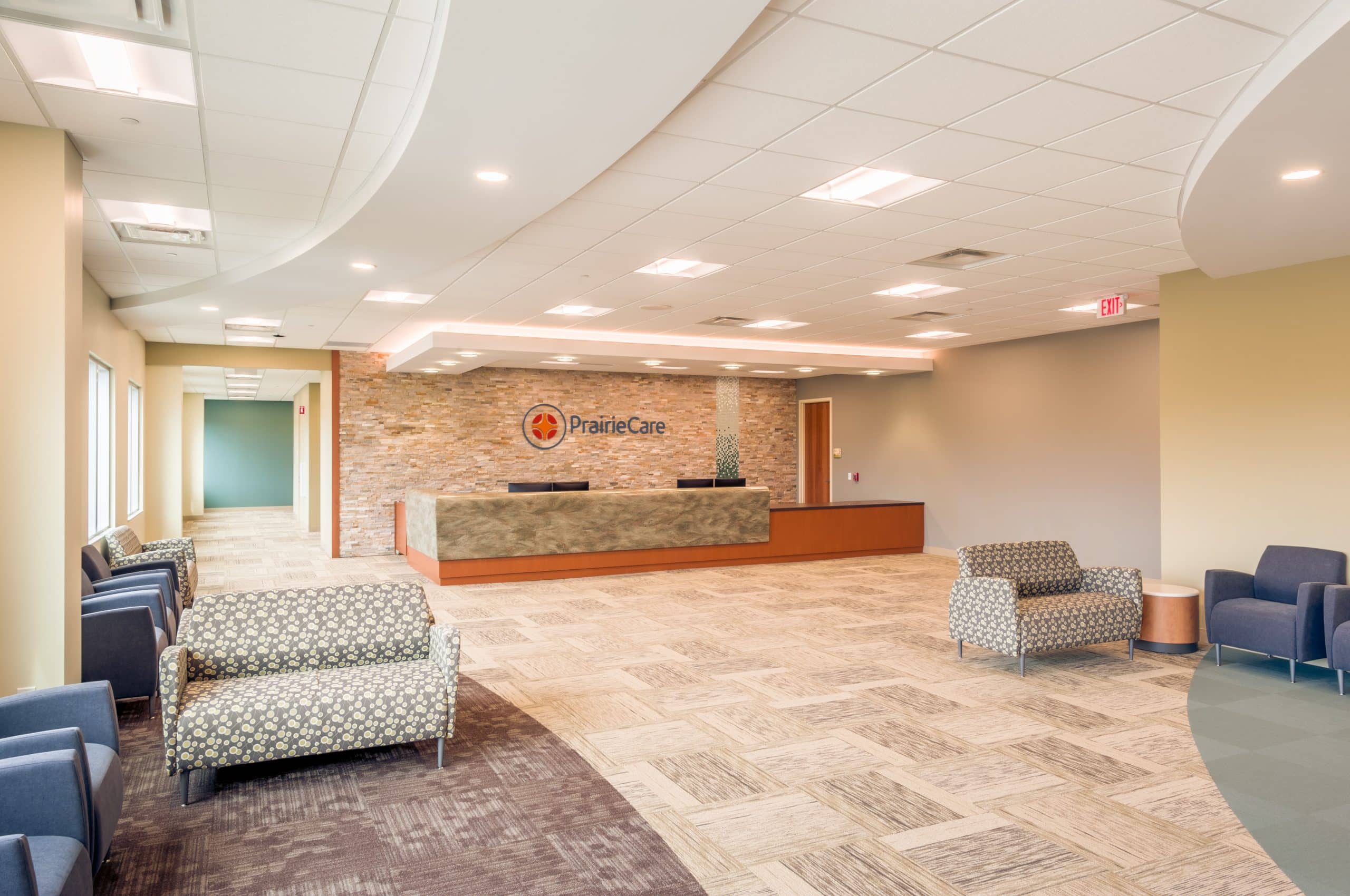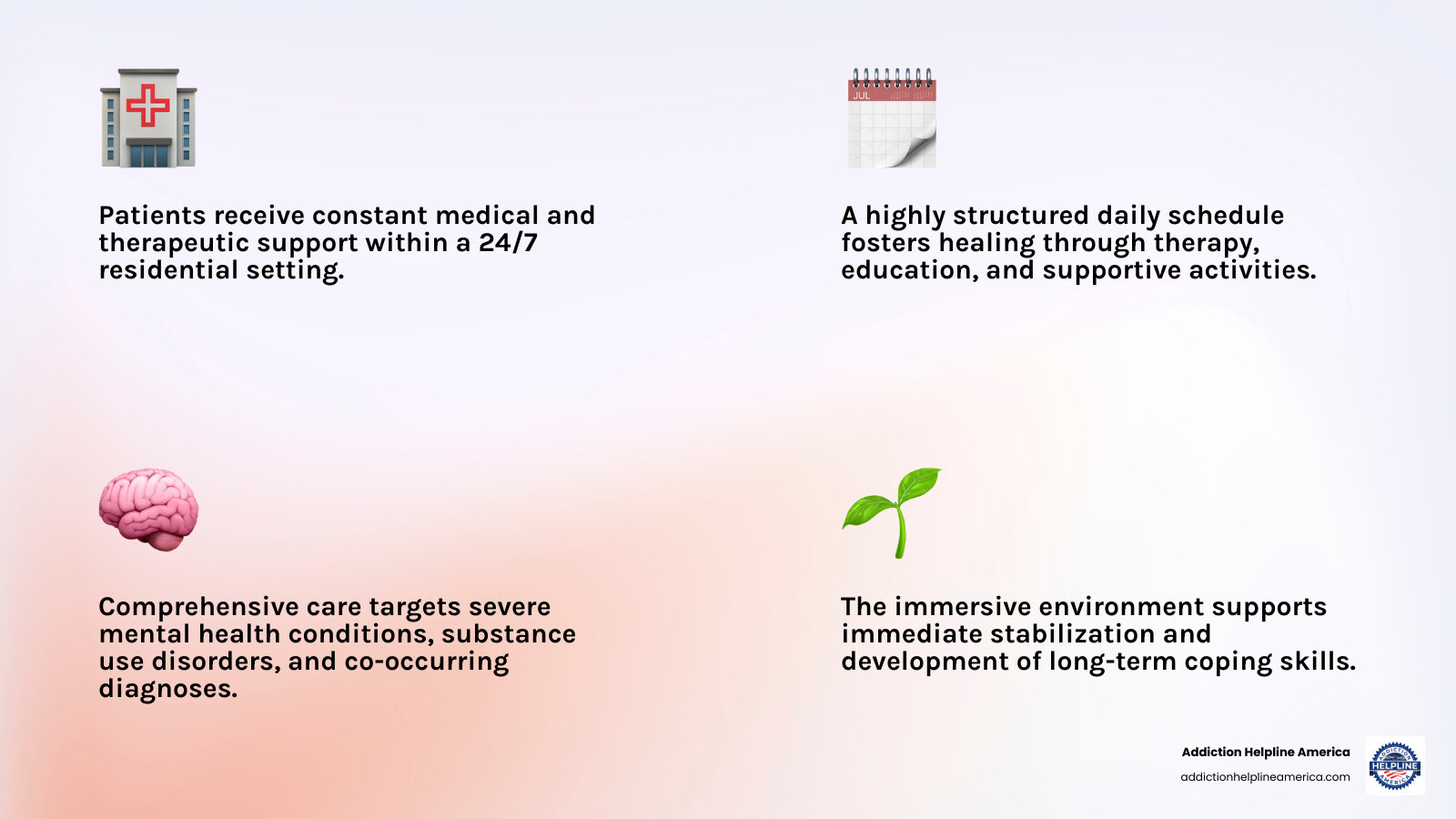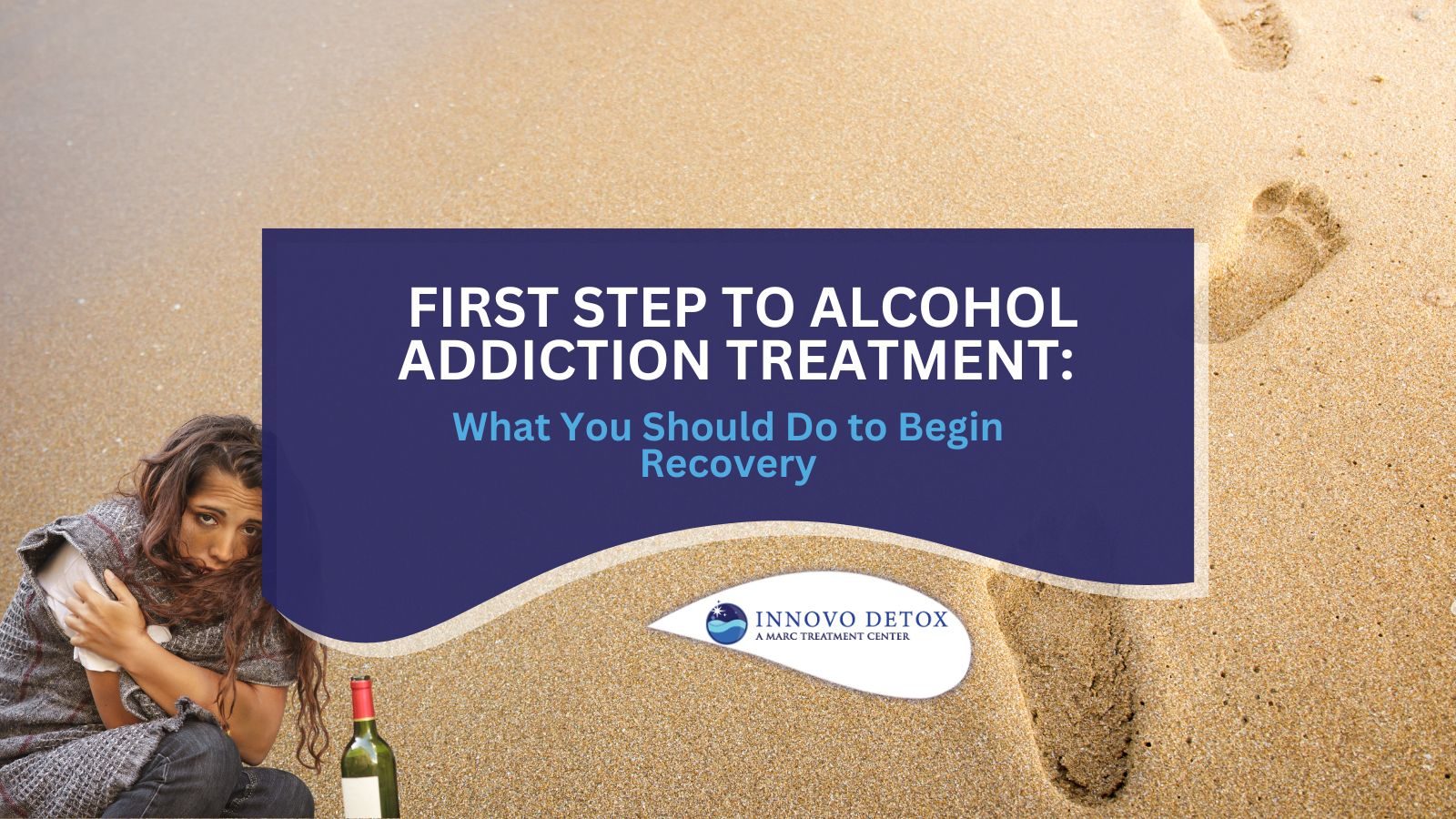
Understanding Intensive Inpatient Therapy
What is Intensive Inpatient Therapy?
- 24/7 Care: Patients live at a facility, receiving constant medical and therapeutic support.
- Structured Environment: A daily schedule of therapy, education, and activities in a safe space.
- Comprehensive Treatment: Addresses severe mental health and substance use issues.
- Stabilization & Recovery: Focuses on immediate crisis stabilization and building long-term coping skills.
- Removal from Triggers: Provides distance from daily stressors and negative influences.
When mental health challenges become overwhelming, intensive inpatient therapy offers a powerful path to healing for those with severe mental illness or substance use disorders. In 2020, nearly one in five American adults struggled with mental illness, and for many, addiction plays a role. Nearly 80% of people in inpatient rehab have a co-occurring mental health condition like depression, anxiety, or PTSD.
This therapy provides a structured, supportive environment where patients live at a facility, receiving 24/7 care. This immersive setting allows individuals to focus solely on recovery, away from daily distractions and triggers. Early studies show intensive therapy significantly decreases anxiety and depression while increasing hope.
At Addiction Helpline America, we understand the complexities of recovery. Our team helps individuals and families steer options, including finding the right intensive inpatient therapy programs custom to their needs.

Intensive inpatient therapy glossary:
Understanding Intensive Inpatient Therapy: What It Is and Who It’s For
When someone is struggling with severe mental health issues or a substance use disorder, intensive inpatient therapy offers a comprehensive and highly supportive environment where healing can truly begin.
Defining Intensive Inpatient Therapy and Its Core Benefits
Intensive inpatient therapy, or residential treatment, is a level of care where patients live at a facility 24/7. This immersive setting provides constant medical and therapeutic support in a safe, structured environment for individuals who require more supervision than outpatient programs can offer.
The core benefits of this approach are numerous:
- 24/7 Medical Supervision: Continuous oversight from medical staff ensures patient safety, which is vital during detox or for managing complex medical conditions.
- Safe and Structured Environment: A secure, predictable routine helps individuals focus on recovery and establish healthy habits, free from outside stressors.
- Distance from Triggers: Removing patients from negative influences and triggers that fuel substance use or worsen mental health symptoms creates a crucial space for healing.
- Peer Support Community: Living with others facing similar challenges fosters a powerful, validating, and motivating sense of community.
- Comprehensive Care Model: A multidisciplinary team integrates various therapies to address a person’s physical, mental, emotional, and spiritual well-being.
To better illustrate the distinction, let’s look at how intensive inpatient therapy compares to outpatient options:
| Feature | Intensive Inpatient Therapy | Outpatient Treatment |
|---|---|---|
| Living Arrangement | Reside at facility 24/7 | Live at home, attend sessions |
| Level of Supervision | Constant, 24/7 medical & therapeutic oversight | Periodic, scheduled visits |
| Intensity | High-frequency, immersive, structured daily programming | Flexible, fewer hours per week, less structured |
| Environment | Controlled, safe, removed from triggers | Maintain daily routines, exposed to home environment/triggers |
| Ideal For | Severe symptoms, crisis, detox, co-occurring disorders | Milder symptoms, post-inpatient step-down, maintaining daily life |
Research supports this approach. A 2012 study showed that intensive therapy significantly decreased anxiety and depression scores while dramatically increasing hope, highlighting the profound impact of these programs.
Conditions and Situations That Warrant This Level of Care
Intensive inpatient therapy is typically recommended when an individual’s mental health or substance use challenges have become severe, posing a risk to their safety or impairing daily functioning. This level of care is often beneficial in the following situations:
- Severe Mental Health Disorders: Inpatient care provides stabilization for conditions like severe depression, bipolar disorder, or acute anxiety when symptoms are unmanageable in an outpatient setting. Our inpatient treatment for depression and anxiety guide offers more insight.
- Substance Use Disorder (SUD): For life-threatening or unmanageable addiction, inpatient therapy provides a structured environment to break the cycle of use and begin healing.
- Medically Supervised Detox: Inpatient settings offer medically managed detox to ensure safety and comfort during the often dangerous withdrawal phase. This 24/7 medical oversight is critical for those with severe issues, as defined by ASAM Level 4 criteria.
- Co-occurring Disorders (Dual Diagnosis): Nearly 80% of people in inpatient rehab have a co-occurring mental health condition like depression or PTSD. Intensive inpatient therapy provides integrated treatment, addressing both conditions at once for more effective recovery.
- Risk of Self-Harm or Harm to Others: The 24/7 supervision in a secure inpatient program is crucial for individuals at risk of harming themselves or others.
- Unsuccessful Outpatient Attempts: If outpatient treatments have failed or multiple relapses have occurred, inpatient therapy offers a more intensive level of care for a breakthrough.
These programs are designed for individuals who need immediate, focused support and a temporary respite from daily responsibilities to concentrate on recovery.
Program Duration and Potential Challenges
The length of an intensive inpatient therapy stay is individualized based on a person’s needs, condition severity, and treatment response.
- Length of Stay Variability: Stays can range from a few days for acute stabilization to several weeks. Shorter options include 14-day rehab and 30-day inpatient rehab programs.
- Long-Term Care Options: For chronic or complex conditions, programs can last much longer. Therapeutic communities may involve stays of 6 to 12 months, as detailed in our 6 month inpatient rehab guide. Duration is adapted to the patient’s progress.
- Factors Influencing Duration: The length of stay depends on symptom severity, co-occurring disorders, therapeutic progress, and the aftercare plan.
While beneficial, intensive inpatient therapy also presents potential challenges:
- Cost: While a significant investment, many facilities work with insurance and offer payment options.
- Time Commitment: An inpatient stay requires stepping away from work, school, and family, which requires planning and support.
- Adjusting to Structure: The highly structured environment can be an adjustment, but it is a cornerstone of the therapeutic process, providing stability.
A Look Inside: The Daily Structure and Therapeutic Approach
Stepping into an intensive inpatient therapy program means entering a dedicated space where healing is the top priority. The supportive, structured environment allows you to focus entirely on your well-being.
What Does a Typical Day in an Intensive Inpatient Program Look Like?

In an intensive inpatient program, your day is built around recovery. While each facility is unique, a common rhythm creates predictability and purpose.
A typical day begins with a morning routine, including breakfast and mindfulness or meditation to start the day with a calm, focused mindset.
Individual counseling provides a safe, one-on-one space with a therapist to explore personal challenges, process trauma, and develop custom coping strategies.
Group therapy connects you with peers who understand your struggles. Sharing experiences builds community and teaches vital skills like relapse prevention, emotional regulation, and healthy coping.
Educational workshops teach the science behind addiction and mental illness, healthy lifestyles, and stress reduction, empowering you on your recovery journey.
Mealtimes are a chance for community, encouraging healthy eating and connection with peers in a relaxed setting.
Holistic activities like yoga, art therapy, or physical exercise offer alternative ways to express yourself, reduce stress, and improve well-being.
The day winds down with evening meetings (like community gatherings or 12-step groups) for reflection and reinforcement. Personal time is also scheduled for journaling or connecting with family. This comprehensive schedule supports your healing journey.
Common Therapeutic Modalities Used
Intensive inpatient therapy uses a mix of proven therapeutic techniques to meet your individual needs. These evidence-based practices address the roots of mental health challenges and addiction, equipping you with skills for lasting change.
Common modalities include Cognitive Behavioral Therapy (CBT), which helps you challenge negative thought patterns, and Dialectical Behavioral Therapy (DBT), which teaches skills in mindfulness, emotional regulation, and distress tolerance.
Motivational Interviewing (MI) strengthens your internal motivation for change, while Eye Movement Desensitization and Reprocessing (EMDR) helps process traumatic memories to reduce their emotional impact.
Medication-Assisted Treatment (MAT) combines behavioral therapies with medications to treat substance use disorders and is often vital for sustained recovery.
Other therapies may include Acceptance and Commitment Therapy (ACT), Interpersonal Therapy (IPT), and Solution-Focused Brief Therapy (SFBT). Programs also use Psychoeducational Groups, Contingency Management (rewards for healthy behaviors), and Twelve-Step Facilitation (TSF) to integrate peer support principles.
The effectiveness of these intensive approaches is well-established. Research has shown that intensive inpatient psychotherapy programs can lead to significant improvements, demonstrating the effectiveness of intensive inpatient psychotherapy for chronic depression.
The Multidisciplinary Team and the Role of Family

You’re not alone on this journey; a dedicated multidisciplinary team brings diverse expertise to care for every part of your well-being.
Your treatment team includes: Psychiatrists for medication and diagnosis; Therapists for individual, group, and family counseling; Nurses for 24/7 medical monitoring; Case Managers for care coordination and discharge planning; and specialized Addiction Counselors. All are highly trained and credentialed to provide expert care.
Family involvement is key to lasting recovery. While family doesn’t cause these issues, their support is vital. Programs often include family therapy sessions to improve communication and dynamics. Educational programs for loved ones teach them about the condition, healthy boundaries, and coping strategies, strengthening the support system for a successful transition home.
Navigating the Logistics: Admission, Costs, and Aftercare
Deciding to pursue intensive inpatient therapy is a brave step. Understanding the practical side—admission, costs, and aftercare—can help ease your mind and make the journey smoother.
The Admission Process and How to Prepare for Your Stay
The admission process is supportive and straightforward. It begins with a confidential assessment with a licensed professional to ensure the program is a good fit. This is followed by insurance verification and an intake process to gather necessary medical and personal details. A professional assessment is always the best way to determine the right level of care.
Once admitted, it’s time to prepare for your stay:
- What to pack: Facilities provide a checklist, but generally, you’ll need comfy clothes, basic toiletries, medications in original bottles, and a journal. Check for restricted items.
- Arranging responsibilities: Before you go, arrange for work, childcare, and bill payments. Informing loved ones can reduce stress and ensure things are handled while you focus on recovery.
Understanding Insurance Coverage and Treatment Costs
The cost of intensive inpatient therapy can be a worry, but many options make it accessible. Costs vary by facility, length of stay, and services. Many centers accept insurance, and we can help you verify your insurance benefits to understand coverage, including deductibles and co-pays.
Without insurance, private pay options like payment plans or sliding scale fees are often available. You can also explore state-funded programs for financial assistance. Resources like the SAMHSA directory can help locate these.
At Addiction Helpline America, our mission is to connect individuals nationwide to the right treatment centers. We offer free, confidential, and personalized guidance. We’re experts at helping you find a recovery program that fits your financial situation and insurance coverage within our vast network.
Discharge Planning and Continuing Care for Lasting Recovery
Finishing an intensive inpatient therapy program is a huge accomplishment, but it’s one step in a lifelong healing journey. A solid discharge plan and continuing care are crucial for maintaining progress and preventing relapse.

Before you leave, your team will help create a detailed aftercare plan to ensure a smooth transition. Continuity of care is vital, as ongoing support is essential when returning to daily life from a structured environment.
Your aftercare plan will likely include recommendations for step-down levels of care:
- Intensive Outpatient Programs (IOP): These offer structured therapy several times a week while you live at home, providing strong support as you transition back to your community. Learn more in our intensive outpatient treatment complete guide.
- Outpatient Therapy: This involves regular individual or group therapy sessions that are less frequent than an IOP.
Sober living environments offer a supportive, substance-free home that bridges the gap between inpatient care and independent living. Many facilities also have alumni support groups for ongoing encouragement.
Finally, your aftercare plan will focus on practicing the relapse prevention skills you learned. This helps you manage triggers and use healthy coping mechanisms to steer your recovery journey with confidence.
Frequently Asked Questions about Intensive Inpatient Therapy
Choosing to pursue intensive inpatient therapy is a significant decision, and it’s natural to have questions. Here are answers to some of the most common concerns we hear.
How do I know if intensive inpatient therapy is the right choice for me?
Deciding if inpatient therapy is right for you is a personal choice, but certain situations indicate it may be the most effective path.
- Severity of symptoms: If mental health challenges are overwhelming, disrupting daily life, or include symptoms like intense depression or psychosis, this level of care provides immediate, intensive support.
- Safety risks: If you have thoughts of harming yourself or others, or need medically supervised detox, the 24/7 supervision of an inpatient setting is essential for safety.
- Co-occurring disorders: For those with both a mental health and substance use issue, an integrated inpatient program is often most effective. Nearly 80% of people in inpatient care manage co-occurring conditions.
- History of relapse: A history of relapse or failure with less intensive treatments suggests it may be time for a more comprehensive approach. Inpatient therapy can offer the reset needed for a breakthrough.
Professional assessment is crucial. While these are helpful indicators, a thorough evaluation by a mental health professional is the only way to know for sure. We can connect you with professionals for an assessment to find the right care.
Can I keep my job and contact my family during my stay?
Facility policies vary, but most programs recognize the importance of staying connected. The initial phase often involves limited outside contact to allow you to immerse yourself in healing without external stressors.
Some facilities offer programs for professionals with limited, structured time for work. However, recovery is always the primary focus, and work is secondary to your health.
Most programs encourage structured family contact through scheduled calls, video chats, or visits. Therapeutic visits and family therapy sessions are often integrated into the treatment plan, allowing loved ones to participate in the recovery journey.
Facilities provide clear communication guidelines on phone and internet use to maintain a therapeutic environment. Discuss these policies with the admissions team to know what to expect.
What makes the therapy “intensive”?
The “intensive” in intensive inpatient therapy refers to several factors that create a uniquely powerful treatment environment.
- High frequency of therapy: You’ll participate in multiple individual and group sessions daily, accelerating the healing process far more than weekly appointments.
- 24/7 structured support: Medical and clinical staff provide a constant safety net for guidance, crisis management, and immediate intervention.
- Immersive therapeutic environment: Every aspect of your day—from meals to activities—is designed to support recovery, fostering self-awareness and peer connection.
- Removal from external stressors: Stepping away from triggers and responsibilities provides the space to focus on inner work and build a foundation for lasting change.
- Comprehensive approach: The therapy integrates evidence-based practices, medical care, psychoeducation, holistic activities, and family involvement into a cohesive plan that addresses the whole person.
Conclusion: Taking the First Step Towards Healing
Intensive inpatient therapy offers a profound opportunity for healing. It’s a place where individuals with significant mental health or substance use challenges can find their footing, providing safety, structure, and comprehensive care.
This is a powerful tool that provides 24/7 medical attention, a shield from triggers, and a strong peer community. A dedicated team uses proven therapies to guide you. If other treatments haven’t worked, inpatient therapy can be the crucial next step toward a healthier future.
It’s easy to feel overwhelmed, but please know this: recovery is absolutely possible with the right support. That’s where Addiction Helpline America comes in. We’re here to help you steer these complex choices, offering free, confidential, and personalized guidance. Our goal is to connect you with the intensive inpatient therapy programs that truly fit your unique needs.
Taking that first step can feel like the hardest part, but you don’t have to walk it alone. Let us be your guide. Ready to explore what’s out there? You can start by exploring different types of treatment programs today. Your path to healing begins now.
Our helpline is 100%
free & confidential
If you or someone you care about is struggling with drug or alcohol addiction, we can help you explore your recovery options. Don’t face this challenge alone—seek support from us.
Programs
Resources
Will my insurance
cover addiction
treatment?
We're ready to help
Find the best
drug or alcohol treatment
center
Are you or a loved one struggling with addiction? Call today to speak to a treatment expert.













